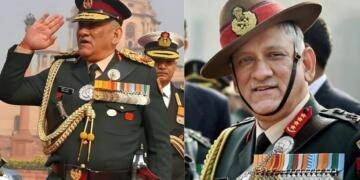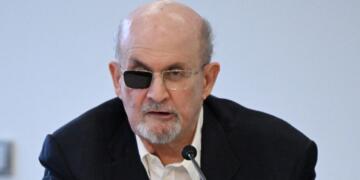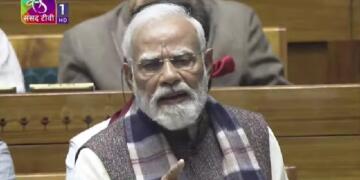It’s another routine day in the world of pseudo-intellectuals looking to ascribe meaning to themselves and their frail identities by besmirching Hindi. Ever since the Zomato customer executive controversy with a customer-led to the unnecessary debate of ‘Hindi imposition’ once again, a few Islamists have crawled out of their burrow holes and tried to pin down Hindi as a language. However, one left-liberal took it a notch further when he claimed that ‘Hindu’ is a Persian word.
Taking him to cleaners, TFI founder Atul Mishra came up with a snippet from Brahspati Sanhita that shut short the fiction writer who writes for propaganda portal Scroll.
He tweeted, “ॐकार मूलमंत्राढ्य: पुनर्जन्म दृढ़ाशय: गोभक्तो भारतगुरु: हिन्दूर्हिंसनदूषक:। हिंसया दूयते चित्तं तेन हिन्दूरितीरित:। (The one who believes in Omkara, the concept of punarjanma (rebirth) and the law of karma as well as protects cows and keeps evil away is Hindu)”
Read more: Hindi imposition? PM Modi wins hearts as he speaks in four languages in Varanasi
Hindi and its perfect framework
Any language and its richness can be gauged by the fact that how many words can be used to describe a single emotion. Hindi or for that matter Sanskrit can be used to extrapolate a single emotion using hundreds of words, whereas, in Urdu, the lexicon is limited to a few words that have become stale over time with repeated, mundane usage.
The framework and grammar of Hindi is sleek and self-assured which cannot be said about Urdu. To put it succinctly, Urdu is nothing but a mix-match of Persian, Turkic, and Arabic vocabulary woven into the Hindustani grammar structure. Often in the folklore, it is termed as the language that originated from the dark dungeons and alleyways of the red-light areas of the Persian world. But as per seculars, it is a culturally rich language.
The literature which doesn’t even have even its own grammar and relies heavily on Hindi to ply its trade is supposed to be better than Sanskrit or Hindi, as far as secular values are concerned.
Social media soldiers battling for Urdu supremacy
The social media soldiers batting for Urdu supremacy on the realms of social media, for the major part of the last few days have been giving examples that Bollywood and its songs and movie titles would have been bland if it wasn’t for Urdu.
Bhar de jholi meri
“Bhar”, “de” and “meri” are Hindi words.
Jholi is a deshaj word with Awadhi origins. https://t.co/JwTAaUWa1u
— Atul Kumar Mishra (@TheAtulMishra) October 20, 2021
However, the bubble was soon ruptured when Mr. Mishra turned Shahrukh Khan’s iconic ‘Chhaiya Chaiyya’ and its Urdu heavy lyrics into a perfect hummable song in under three minutes.
Similarly, to demonstrate how crude Urdu can be at times, he tried to Urdu-ize the works of legendary Hindi poet Maithili Sharan Gupt. Not surprisingly, the end product was miles off the essence of the works of Sharan and looked like it was penned by a novice who didn’t have any idea of the soul that Sharan’s work carried.
Funnily even the most Urdu heavy songs can be turned into perfectly hummable Hindi songs
This is Chhaiya Chhaiya. It took me 3 mins 😂 pic.twitter.com/yFjyRX6Syw
— Atul Kumar Mishra (@TheAtulMishra) October 20, 2021
This is not the first time that Mr. Mishra has translated a few heavy Urdu-laden songs with some elan and given them a unique spin. Not only did he translate the songs into Hindi but he sang them as well, further rubbing in on the misery of Urdu supremacists. The end product was unsurprisingly soothing to the ears and perhaps even pipped the original version. Such is the beauty of the Hindi language.
Alright consider it done https://t.co/Z2BKU4Veil
— Atul Kumar Mishra (@TheAtulMishra) July 15, 2020
A delusional Bollywood
The bulk of Shayari (which is promoted as something as grand as astrophysics in Hindi cinema), consists of the poet or protagonist fantasizing about how a woman would look once her veil is off. Urdu is promoted as a rich and cultural language in the supposed aristocratic class of the country with Bollywood leading the way.
A sherwani-wearing Khan Sahab who starts every discussion with “barkhurdar” is seemingly mature and upright, with deep insight on life. On the contrary, someone who speaks shuddh Hindi is always taken to be a bumbling idiot.
For a Bollywood still stuck on words such as Dil, Jigar, Nazar, Sanam, Kasam, Humsafar, Nadaan, Iqraar, Izhaar, Eitbaar, Dilbar, Hosh, Madhosh, Dhadkan, Inkaar, Mehboob, Mohabbat, Khat, Dua, Tanhai, Khayal, Lafz, Ishq, Ashiq, Allah, Maula, Khuda, Jazbaat, Beqaraar — it is difficult to make them understand the beauty of Hindi.
Read More: Next time when You say We have a “Hindi” Film Industry, Think thrice.
The use of Hindustani/Urdu has been so extensive in Bollywood, that its viewers cannot even imagine that songs can be written without calling anyone “jaanejaan” or giving your “dil” to them. Bollywood calls itself a Hindi film industry; it’s actually a Hindustani film industry. Hindustani has the grammatical structure of Hindi, but it replaces most of the Sanskrit-based vocabulary with the words originating from Persian, Arabic, and Chagatai (Turkic).
Bollywood wants to remain in the utopia that Hindi and Bharat will cease to exist if there was no Urdu. However, the truth is other way around. Urdu needs Hindi to breathe. Its existence is borne out of the evolution of Hindi.
When one has to put down an ancient language to elevate a relatively modern borrowed language, understand that the argument is flawed from the beginning. And that is where the Urdu fanatics masquerading as aficionados are often found wanting.





























Excellent response by Mishra Ji. Sanskrit is the one of the oldest known most matured language which not only have both dialect and script but is also root for the birth of many regional Indo-Asian languages including Hindi and there were scriptures, poetry, folk songs and hundreds of scholars, poets who have produced endless contents based on the Sanskrit.
Sanskrit continues to be one of the best language that even modern computer languages are influenced today, if someone don’t believe they should learn about the decades of research going on the Sanskrit language in Germany and how they were able to use Sanskrit in the modern science.